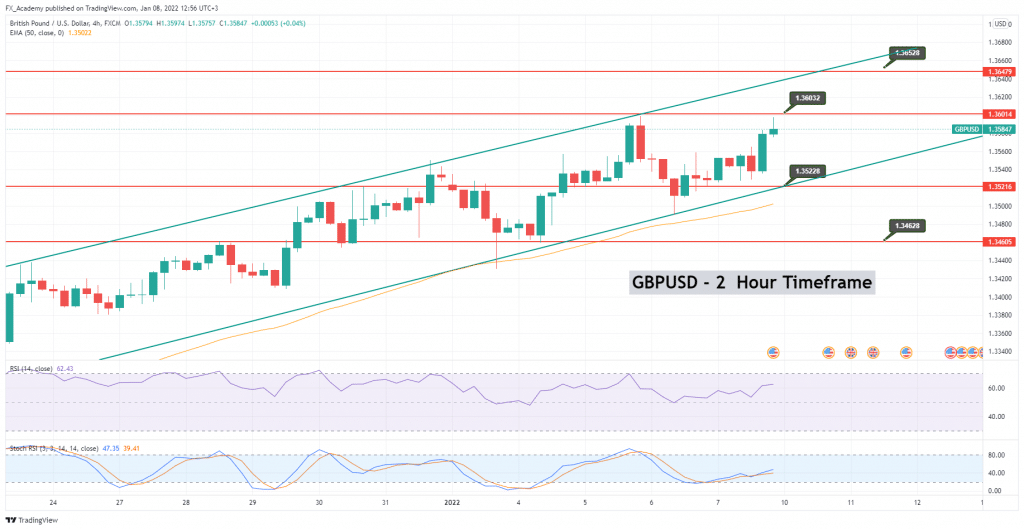GBP/USD Price Forecast – US Inflation and UK GDP under the Spotlight
Please note that we are not authorised to provide any investment advice. The content on this page is for information purposes only.
- US nonfarm employment change dropped to 199K from the anticipated 426K.
- UK GDP figures for November will be released on Tuesday of next week.
- GBP USD pair may find immediate resistance at 1.3600 or 1.3652 levels on the bullish side.
The GBP/USD price forecast remains bullish above the 1.3525 support level, and a break above 1.3600 will trigger a further uptrend in the market. The GBP/USD closed at $1.3583 after setting a high of $1.3598 and a low of $1.3527. The exchange rate reversed its course on Friday and turned green to recover its previous daily loss.
Refer to our trading guides to enhance your forex trading skills.
A weaker dollar underpins GBP/USD
The prevailing weakness of the US dollar could be behind the sudden rise in GBP/USD on the last day of the week. The US Dollar Index, which measures the greenback’s value against a basket of six major currencies, dropped to the 95.71 level. The subdued momentum of the US dollar was driven by the NFP report released by the US labor market. Last month, job creation in the US fell short of expectations and weighed heavily on the greenback. The lack of job creation might be due to the halted activities amid the Omicron variant spread. This weighed heavily on the greenback and helped GBP/USD place the day’s gains.
A quick economic event outlook
At 12:00 GMT, the Halifax HPI remained flat on the data front with expectations of 1.1%. At 14:30 GMT, the construction PMI surged to 54.3, against the forecasted 53.9, and supported the British pound. The Housing Equity Withdrawal for the quarter dropped to-7.1B against the anticipated 3.8B and weighed on the British pound. Data from the UK was mixed on Friday, but the positive data got more attention from investors, and the GBP/USD started to rise.
On the US side, average hourly earnings surged by 0.6%, against the forecasted 0.4%, and the US dollar was supported. The non-farm employment change dropped to 199K from the anticipated 426K and weighed on the US dollar. The unemployment rate fell to 3.9%, against a projected 4.1%, and the US dollar was supported. Most data from the US came in favor of the local currency and capped further gains in GBP/USD.
On the other hand, the British pound was moving sideways as the soaring coronavirus cases, and severe NHHS staff shortages placed pressure on the Sterling, while the British pound was supported by rising expectations of an early interest rate hike by the Bank of England. Over the past week, the UK has reported more than 150,000 coronavirus cases every day, and the government has brought in about 200 members of the Armed Forces to help support the NHS operations in London. Due to the significant spread of the Omicron variant throughout the country, staff absences at hospitals across England increased by 60%.
What’s next?
The economy of the United States is doing well. The labor market is expected to recover to full employment this year. Consumption is brisk, the Atlanta Fed GDPNow model predicts 6.7 percent growth in the fourth quarter, and inflation is soaring.
As a result, markets have begun to consider the possibility that the Fed may hike interest rates as early as March. This will be required to combat inflation, and markets are already pricing in an 85 percent chance of such action. This has been a boon to the dollar but a curse to the yen, as the Bank of Japan is unlikely to follow suit anytime soon.
Eyes on US CPI
The next CPI inflation data on Wednesday and retail sales report on Friday may be critical in this context. The yearly CPI rate is predicted to have remained stable at 6.8 percent in December. But the core figure, which excludes energy and food prices, is expected to have risen to 5.4 percent from 4.9 percent earlier. Markit’s most recent PMI surveys back up these predictions. First, companies’ selling prices ‘increased substantially,’ but at the slowest rate in three months. It’s exactly what the monthly CPI print is projected to reflect.
The British GDP is about to rise.
The British pound has also significantly benefited from the recent rise in yields. Investors appear to have determined that Omicron is not risky enough to prevent the Bank of England from raising interest rates or even delaying its plans. Money markets presently give the BoE a 70% likelihood of raising rates again next month, for a total of four hikes this year. This, combined with Prime Minister Johnson’s comments that fresh COVID restrictions are unlikely, helped push the euro/sterling to a new post-pandemic low this week.
The GDP figures for November will be released on Tuesday of next week. But they are unlikely to affect the sunny picture. For the time being, there is still room for sterling to extend its recent gains, at least versus the euro and yen. That’s because traders are building confidence in a February rate hike. However, there are some risks in the big picture. While the British labor market is strong and has high inflation, the most recent PMI surveys indicate that economic growth is slowing. If this pattern continues, the Bank of England may only hike interest rates twice or three times this year, rather than the four times markets anticipate.

GBP/USD Price Forecast – Daily Technical Levels
Support Resistance
1.3491 1.3563
1.3454 1.3598
1.3420 1.3635
Pivot Point: 1.3526
GBP/USD Price Forecast – Upward channel to support at 1.3522
The GBP/USD price forecast is bullish as the pair is trading bullish to reach above the 1.3584 level. However, the closing of candles above the 1.3522 support signals the chances of uptrend continuation. The GBP/USD pair surged during the early European hours and closed above 1.3525, right above the resistance that became support. The pair has formed a tweezer bottom on the 4-hourly timeframe, supporting the chances of an uptrend continuation in GBP/USD.
The GBP/USD pair may find immediate resistance at 1.3600 or 1.3652 levels on the bullish side. Taking a look at the leading technical indicator such as the RSI, it’s holding near 62. Suggesting odds of an uptrend continuation in the GBP/USD pair. Likewise, GBP/USD retests and closes above the 1.3525 support zone, which is extended by an upward trendline. Thus, the chances of an upward movement remain solid.
Alternatively, a break below the 1.3525 support could allow further room for selling until the 1.3462 and 1.3420 marks are reached. Good luck, and stay tuned for more updates!





